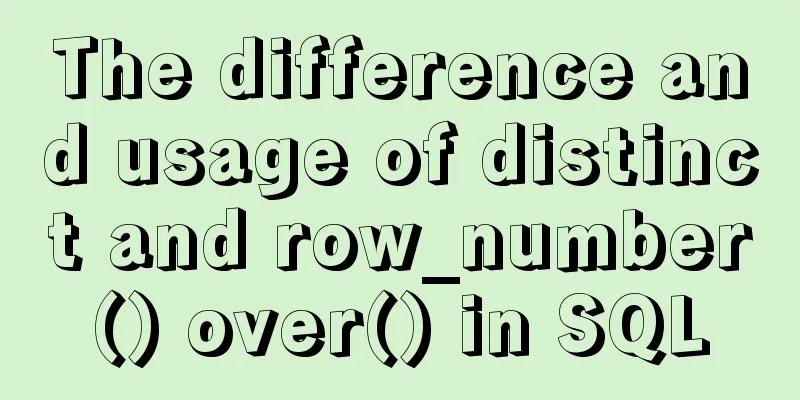Vue Basics Introduction: Vuex Installation and Use

|
This tutorial is an introductory tutorial. If there are any errors, please point them out. 1. What is vuexVuex is a state management pattern developed specifically for Vue.js applications. It uses centralized storage to manage the status of all components of the application, and uses corresponding rules to ensure that the status changes in a predictable way. For detailed information, please refer to the official website document vuex.vuejs.org/zh/ The following is a brief introduction to vuex 2. Installation and introductionInstall vuex first. npm install vuex --save It can be used after being introduced in main.js. // The Vue build version to load with the `import` command
// (runtime-only or standalone) has been set in webpack.base.conf with an alias.
import Vue from 'vue'
import App from './App'
import router from './router'
//vuex uses import Vuex from 'vuex'
Vue.use(Vuex)
const store = new Vuex.Store({
state: {
//Global variable count: 31231
}
})
Vue.config.productionTip = false
/* eslint-disable no-new */
new Vue({
el: '#app',
router,
//vuex must be added to the store,
components: { App },
template: '<App/>'
})
3. Use of vuex<template>
<div>
The boss has {{showData}}
<HelloWorld2/>
</div>
</template>
<script>
import HelloWorld2 from './HelloWorld2'
import son from './son'
export default {
name: 'HelloWorld',
data () {
return {
message2:"",
cou
}
},
components:{
HelloWorld2,
son
},computed: {
showData(){
return this.$store.state.count;
}
}
}
</script>
<template>
<div>
The second one has {{$store.state.count}}
</div>
</template>
<script>
export default {
name: 'HelloWorld2',
data() {
return {
}
}
}
</script>
4. Process Introduction
As shown in the figure, when vuex is not used, the process is: view->actions->state->view After using vuex, the process is vuecomponent->(dispatch)actions->(commit)mutations->(mutate)state->(render)->vuecomponent 5. mutationState changes, the only way to change the state in the Vuex store is to submit a mutation. Mutations in Vuex are very similar to events: each mutation has a string event type (type) and a callback function (handler). This callback function is where we actually make the state change, and it receives state as the first argument. // The Vue build version to load with the `import` command
// (runtime-only or standalone) has been set in webpack.base.conf with an alias.
import Vue from 'vue'
import App from './App'
import router from './router'
//vuex uses import Vuex from 'vuex'
Vue.use(Vuex)
const store = new Vuex.Store({
state: {
//Global variable count: 31231
},
//Change state method mutations: {
//state is the state above
addData(state) {
//Change state state.count++
}
}
})
Vue.config.productionTip = false
/* eslint-disable no-new */
new Vue({
el: '#app',
router,
//vuex must be added to the store,
components: { App },
template: '<App/>'
})
Then perform the change <template>
<div>
The boss has {{showData}}
<HelloWorld2/>
<button type = "button" v-on:click = "changeData"> Modify button</button>
</div>
</template>
<script>
import HelloWorld2 from './HelloWorld2'
import son from './son'
export default {
name: 'HelloWorld',
data () {
return {
message2:"",
}
},
components:{
HelloWorld2,
son
},computed: {
showData(){
return this.$store.state.count;
}
},
methods: {
//Execute changes changeData(event){
this.$store.commit("addData");
}
}
}
</script>
6. Getters filteringYou can limit mutations, for example, if the mutation is less than 0, it cannot be reduced. // The Vue build version to load with the `import` command
// (runtime-only or standalone) has been set in webpack.base.conf with an alias.
import Vue from 'vue'
import App from './App'
import router from './router'
//vuex uses import Vuex from 'vuex'
Vue.use(Vuex)
const store = new Vuex.Store({
state: {
//Global variable count: 0
},
//Change state method mutations: {
//state is the state above
addData(state) {
//Change state state.count++
}
},
//Filter getters: {
getState(state) {
if (state.count >= 5) {
return 5
} else {
return state.count
}
}
}
})
Vue.config.productionTip = false
/* eslint-disable no-new */
new Vue({
el: '#app',
router,
//vuex must be added to the store,
components: { App },
template: '<App/>'
})
When calling <template>
<div>
The second one has {{$store.getters.getState}}
</div>
</template>
<script>
export default {
name: 'HelloWorld2',
data() {
return {
}
}
}
</script>
7.Action--Asynchronous ProcessingAction is similar to mutation, except that: Action submits a mutation, rather than directly changing the state. Action can contain arbitrary asynchronous operations. Mutations can only be processed synchronously // The Vue build version to load with the `import` command
// (runtime-only or standalone) has been set in webpack.base.conf with an alias.
import Vue from 'vue'
import App from './App'
import router from './router'
//vuex uses import Vuex from 'vuex'
Vue.use(Vuex)
const store = new Vuex.Store({
state: {
//Global variable count: 0
},
//Change state method mutations: {
//state is the state above
addData(state) {
//Change state state.count++
}
},
//Filter getters: {
getState(state) {
if (state.count >= 5) {
return 5
} else {
return state.count
}
}
},
actions: {
//The advantage of the action-triggered mutations method is asynchronous processing addData(context) {
//Simulate asynchronous setTimeout(() => {
context.commit('addData')
}, 1000)
}
}
})
Vue.config.productionTip = false
/* eslint-disable no-new */
new Vue({
el: '#app',
router,
//vuex must be added to the store,
components: { App },
template: '<App/>'
})
action should be called when sending. <template>
<div>
The boss has {{showData}}
<HelloWorld2/>
<button type = "button" v-on:click = "changeData"> Modify button</button>
</div>
</template>
<script>
import HelloWorld2 from './HelloWorld2'
import son from './son'
export default {
name: 'HelloWorld',
data () {
return {
message2:"",
}
},
components:{
HelloWorld2,
son
},computed: {
showData(){
return this.$store.getters.getState;
}
},
methods: {
//Execute changes changeData(event){
//Operation mutations method //this.$store.commit("addData");
//The action should be operated instead of the mutation method triggered by the action this.$store.dispatch("addData");
}
}
}
</script>
8.ModuleBy using a single state tree, all application states are centralized into one large object. When your application becomes very complex, the store object may become quite bloated. To solve the above problems, Vuex allows us to split the store into modules. Each module has its own state, mutation, action, getter, and even nested submodules - split in the same way from top to bottom: If the route can be split, the file is not put into main.js and is placed in vuex. Create a new store/index.js //vuex uses import Vue from 'vue'
import Vuex from 'vuex'
Vue.use(Vuex)
export default new Vuex.Store({
state: {
//Global variable count: 0
},
//Change state method mutations: {
//state is the state above
addData(state) {
//Change state state.count++
}
},
//Filter getters: {
getState(state) {
if (state.count >= 5) {
return 5
} else {
return state.count
}
}
},
actions: {
//The advantage of the action-triggered mutations method is asynchronous processing addData(context) {
//Simulate asynchronous setTimeout(() => {
context.commit('addData')
}, 1000)
}
}
})
Modify main.js // The Vue build version to load with the `import` command
// (runtime-only or standalone) has been set in webpack.base.conf with an alias.
import Vue from 'vue'
import App from './App'
import router from './router'
import store from './store'
Vue.config.productionTip = false
/* eslint-disable no-new */
new Vue({
el: '#app',
router,
//vuex must be added to the store,
components: { App },
template: '<App/>'
})
We can also take the state in main.js and create a new store/state.js export default {
count: 0
}
Then index.js can be changed to //vuex uses import Vue from 'vue'
import Vuex from 'vuex'
import state from './state'
Vue.use(Vuex)
export default new Vuex.Store({
state: state,
//Change state method mutations: {
//state is the state above
addData(state) {
//Change state state.count++
}
},
//Filter getters: {
getState(state) {
if (state.count >= 5) {
return 5
} else {
return state.count
}
}
},
actions: {
//The advantage of the action-triggered mutations method is asynchronous processing addData(context) {
//Simulate asynchronous setTimeout(() => {
context.commit('addData')
}, 1000)
}
}
})
SummarizeThis is the end of this article about vuex installation and usage for vue beginners. For more information about vuex installation and usage, please search for previous articles on 123WORDPRESS.COM or continue to browse the following related articles. I hope you will support 123WORDPRESS.COM in the future! You may also be interested in:
|
<<: Implementation of two basic images for Docker deployment of Go
>>: Steps to modify the MySQL database data file path under Linux
Recommend
Markup language - specify CSS styles for text
Click here to return to the 123WORDPRESS.COM HTML ...
What is flex and a detailed tutorial on flex layout syntax
Flex Layout Flex is the abbreviation of Flexible ...
Vue.js uses Element-ui to implement the navigation menu
This article shares the specific code for impleme...
How to show or hide common icons on the desktop in Windows Server 2012
Windows Server 2012 and Windows Server 2008 diffe...
A brief discussion on DDL and DML in MySQL
Table of contents Preface 1. DDL 1.1 Database Ope...
CSS3 uses the transition property to achieve transition effects
Detailed description of properties The purpose of...
XHTML Getting Started Tutorial: Using the Frame Tag
<br />The frame structure allows several web...
How to connect to a remote server and transfer files via a jump server in Linux
Recently, I encountered many problems when deploy...
Tutorial on building file sharing service Samba under CentOS6.5
Samba Services: This content is for reference of ...
HTML exceeds the text line interception implementation principle and code
The HTML code for intercepting text beyond multipl...
Methods and steps for deploying GitLab environment based on Docker
Note: It is recommended that the virtual machine ...
MySQL database introduction: detailed explanation of database backup operation
Table of contents 1. Single database backup 2. Co...
Understanding and application of JavaScript ES6 destructuring operator
Table of contents Preface The role of deconstruct...
Docker large-scale project containerization transformation
Virtualization and containerization are two inevi...
vue+el-upload realizes dynamic upload of multiple files
vue+el-upload multiple files dynamic upload, for ...











